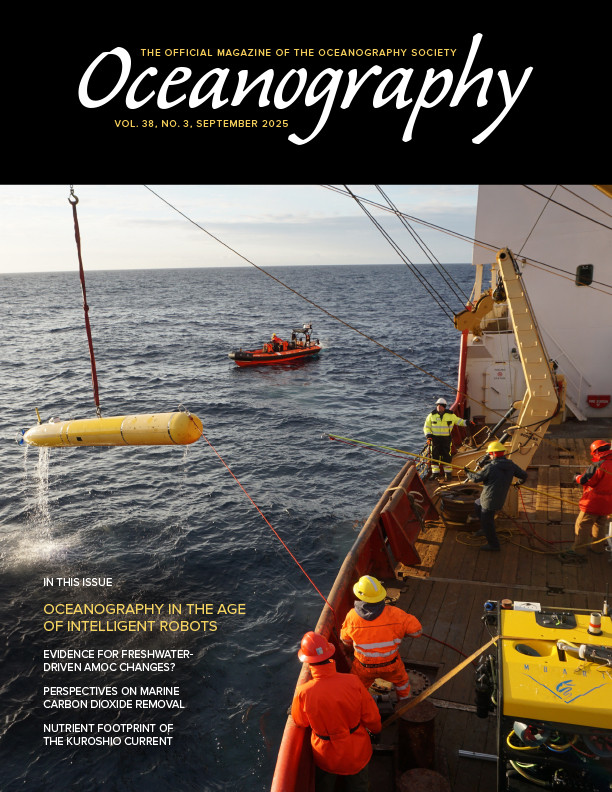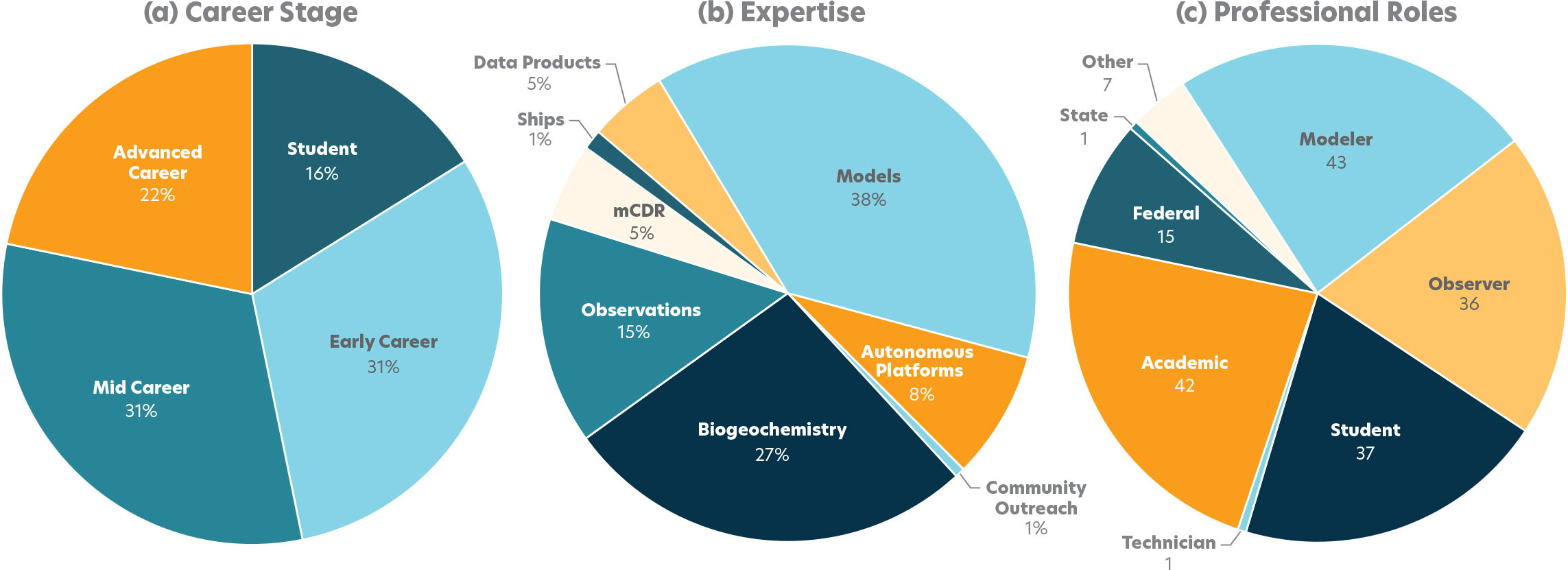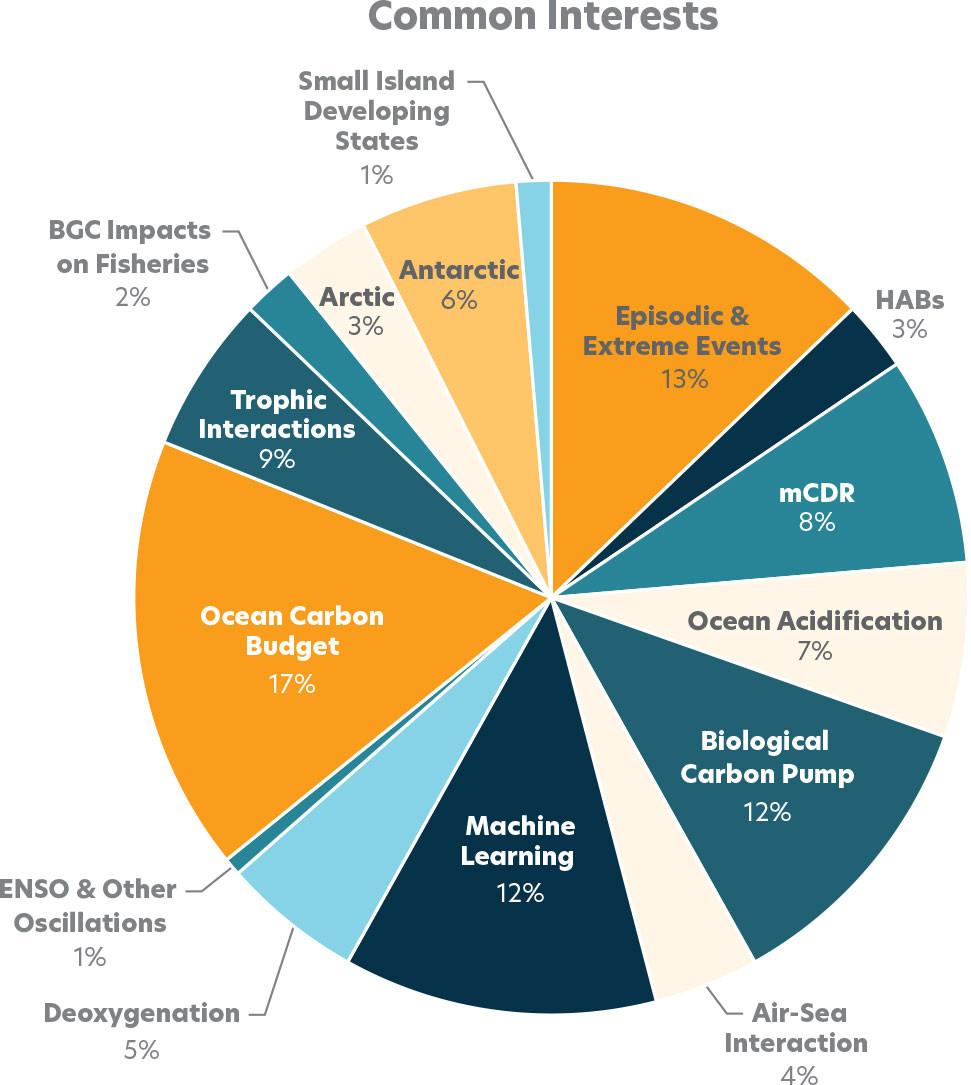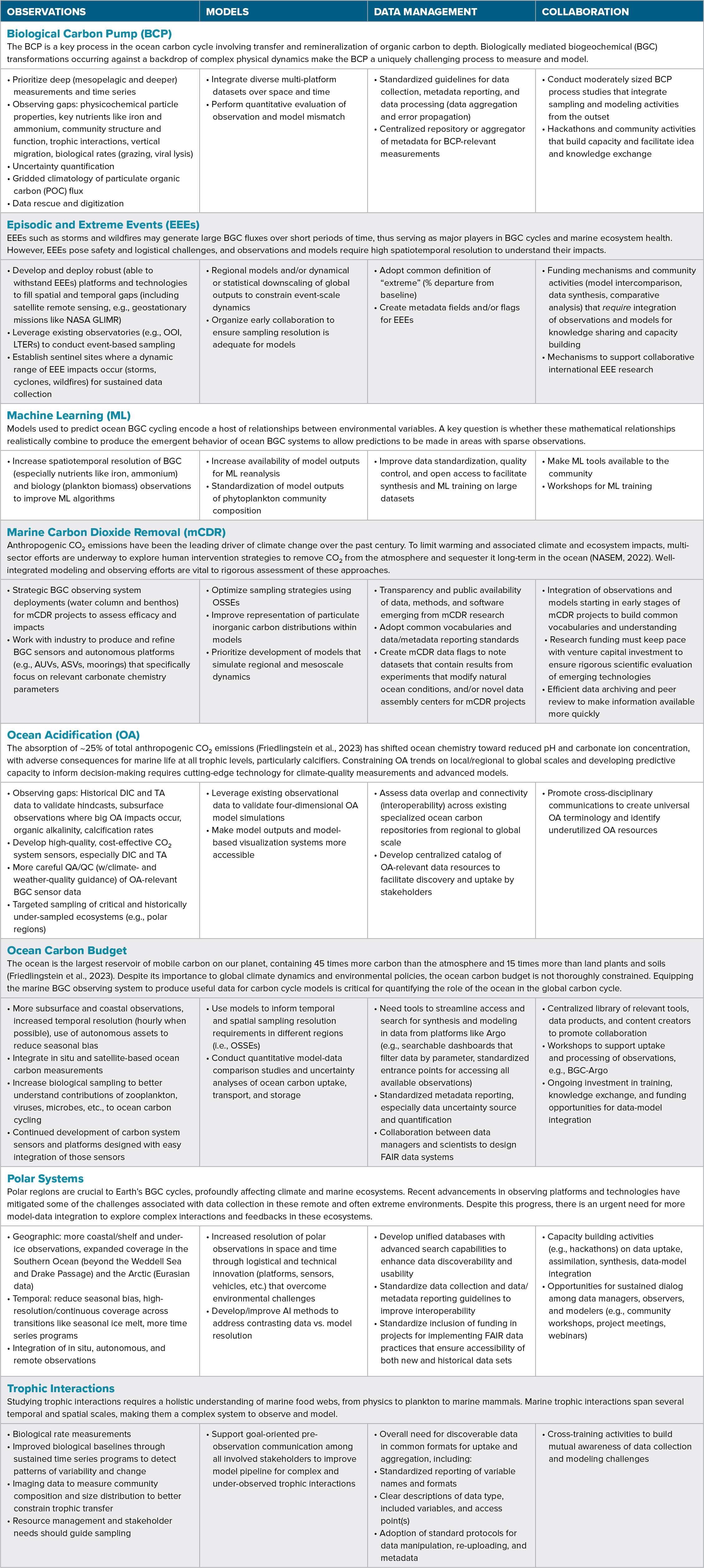Full Text
Introduction
Increasingly complex and severe impacts of global change require collaboratively developed tools that simultaneously address multiple applications/uses. It is critical to come together as a research community to co-develop ocean biogeochemical observing networks and models that support research and monitoring, decision-making, operational forecasting, and other stakeholder applications. Despite serving as two major research tools in ocean science, ocean observing and modeling tend to act as distinct scientific communities composed of researchers with different skill sets, training, preferred methodologies, and vocabularies. This division often results in missed opportunities for synthesis, challenges in data integration, and inefficient use of resources. Bridging these divides is essential for addressing urgent challenges in ocean sciences.
To reduce communication barriers and facilitate discussion on scientific questions of mutual interest, NOAA’s Ocean Acidification Program and Global Ocean Monitoring and Observing Program, NASA’s Ocean Biology & Biogeochemistry Program, and the US Ocean Carbon and Biogeochemistry Project Office co-convened a workshop—Biogeochemical Observing and Modeling Workshop: Connecting Observations to Models—during the February 2024 Ocean Sciences Meeting (New Orleans, Louisiana, USA). This workshop provided a space for scientists trained in different disciplines of ocean modeling and observing to make connections, assess observing and modeling needs and capabilities within focused areas of interest, and identify synergies and collaborative opportunities. Here, we share high-level recommendations and opportunities for enhanced collaboration that emerged from the workshop to inform and activate the broader oceanographic community. A more detailed synthesis of the workshop discussions is available in the full workshop report (Ombres et al., 2024).
Workshop Dynamics: Fostering a Dialog
To ensure focused and purposeful interactions, workshop organizers polled prospective participants prior to the workshop across their respective ocean biogeochemical (BGC) networks on potential topics of interest. One hundred twenty-four (124) responses representing a range of career stages, expertise, and professional roles were collected (Figure 1).
|
|
Workshop organizers used these responses to identify topical discussion areas and design a common set of guiding questions to frame small group discussions. Common interests included (Figure 2):
- Ensuring adequate observational coverage for the questions and scales of interest
- Addressing data management challenges
- Collecting chemical and biological measurements simultaneously
- Addressing contrasting resolutions in datasets
- Deploying autonomous observing technology to fill spatial and temporal gaps
- Evaluating marine carbon dioxide removal (mCDR) methods
- Investing in long-term research efforts
- Supporting development of data products
- Ensuring community engagement and inclusivity
- Increasing opportunities for integration of observations and models
|
|
Over 100 people participated in the workshop, which was designed to provide an interactive space for ocean scientists to communicate with each other and with funding agencies about challenges and opportunities in this field. To kick off the workshop, participants voted on the topics they were most interested in discussing. The selected topics included: ocean carbon budget, episodic and extreme events (EEEs), machine learning (ML), biological carbon pump (BCP), ocean acidification, trophic interactions, polar systems, and mCDR.
Participants chose two of the topics identified and participated in two 30-minute discussion periods on these topics. Throughout the discussions, participants identified observing and modeling needs, data management challenges, and opportunities for collaboration for each discussion topic (Table 1).
Four questions framed the discussions:
- What expansion beyond current observations is needed for model development?
- How can we increase discoverability, synthesis, and model development through data management practices?
- How do we resolve the contrasting resolutions between data and models for increased understanding?
- What channels exist for connections between observers and modelers? How can we foster more conversation?
TABLE 1. Abridged summary of priorities for addressing needs and challenges related to biogeochemical observations, models, data management, and collaboration for each discussion topic. > High res table |
Key Findings and Recommendations for Addressing Contemporary Ocean Research Challenges
Several overarching challenges and opportunities emerged from the topical discussions, providing a blueprint for improved collaboration and more integrated approaches to research, observing system design, and model development. These opportunities and suggestions for future actions are highlighted below.
Designing Integrated Ocean Observing Systems
Today’s ocean research and monitoring activities face a fundamental challenge: the need for seamless integration of observing systems and models to promote understanding and prediction of ocean processes. While observational gaps limit model development, model limitations also affect our ability to optimize observing strategies. This interdependency requires rethinking how we design and implement both tools to address contemporary challenges in ocean research.
Critical gaps persist in our observing capabilities that affect both monitoring and modeling efforts. The ocean BGC observing community particularly needs increased sampling resolution to reduce three-dimensional spatial and temporal biases. For instance, wintertime sampling remains a significant challenge in high-latitude regions due to sea ice coverage and adverse sea conditions (Heimdal et al., 2024). Several regions (e.g., polar, tropical Pacific, Indian Ocean) and depths below the surface layer of the ocean are relatively undersampled (Abrahamsen, 2014; Levin et al., 2019; Smith et al., 2019). Across biogeochemistry disciplines, specific variables and processes are necessary to measure but remain undersampled. Measurement, monitoring, reporting, and verification of mCDR projects require information about baseline ocean biogeochemistry (Fay et al., 2024; Ho et al., 2023). The biological pump observing community requires the constraint of high trophic level processes in addition to measurements of physicochemical particle properties, including sinking velocity, porosity, and chemical composition, for more accurate calculations of particulate organic carbon flux. Ocean biological parameters are globally undersampled relative to physics and chemistry and are especially lacking for subsurface and benthic systems. Biological rate measurements (e.g., grazing, productivity, viral lysis, and respiration) important for model accuracy are relatively sparse due to the time and resources required to obtain them. Rate measurements are further limited by a lack of standardized approaches and poorly constrained discrepancies between in situ and incubation-based approaches. Co-collection of biological, chemical, and physical data via the augmentation of existing and the development of new observing systems is recommended to provide a more holistic understanding of ocean processes.
Filling observing gaps will require continued progress in development and deployment of sensors and platforms that can access more extreme depths and environments. Sustained investment in observing infrastructure that transcends disciplines and strategically combines temporal and spatial (latitude, longitude, depth) coverage of the ocean is essential in order to address the challenges that lie before us. This infrastructure will likely include a combination of repeat hydrography lines (e.g., RAPID array, Extended Ellett Line), shipboard time-series programs (e.g., Bermuda Atlantic Time-series Study, Hawaii Ocean Time-series, Porcupine Abyssal Plain Sustained Observatory, the Global Ocean Ship-based Hydrographic Investigations Program), Long-Term Ecological Research stations, long-term monitoring stations (e.g., Ocean Observatories Initiative and NOAA Ocean Acidification Observing Network moorings), sentinel sites for extreme events, autonomous platforms (e.g., floats like BGC Argo, gliders, autonomous surface vehicles), platforms of opportunity (e.g., commercial fishing and cargo ships), and airborne and satellite-based measurements, among others. Observation System Simulation Experiments (OSSEs) may be useful for coordinating and optimizing observing system design in order to inform reallocation of resources as scientific grand challenges and priorities change. Improved coordination and integration of coastal observing assets is especially critical for monitoring and addressing ongoing threats to human communities and the marine ecosystem services on which they rely.
Gridded observational BGC data products (e.g., Global Ocean Data Analysis Project [GLODAP], Surface Ocean CO2 Atlas [SOCAT], World Ocean Atlas [WOA]) are important tools for supporting ocean research and climate monitoring as well as model evaluation and development. These products will require continued advancement of artificial intelligence (AI), machine learning (ML), and statistical analysis tools to address sampling gaps and to improve spatial resolution. Additionally, measurements that appear to be very important in the current generation of models (ammonium and iron) are not currently available as gridded variables.
Cloud-based computing environments (e.g., Pangeo) provide open-source frameworks that streamline access to standardized data and model outputs, software, and data analysis tools. They centralize and democratize access and also facilitate collaboration and model intercomparison. For example, Model Intercomparison Projects (MIPs) have become effective community exercises for assessing model performance and system sensitivity to anthropogenic changes. However, more sophisticated approaches are needed to evaluate why the models differ from observations and from each other, and further to guide improvements in how fundamental processes are represented. Shared computing environments allow users to work collaboratively with models produced by MIPs whose sizes might be prohibitive for personal computers.
Co-development design should be implemented in future projects/endeavors. Rather than accessing datasets after the completion of a project, all involved end users must have the opportunity to engage early in the planning stages of a project or process study to develop a common understanding of data collection priorities, challenges, and opportunities. Models and data assimilation and analysis tools can inform data collection (e.g., OSSEs), which can help optimize sampling strategies. Similarly, model-data integration activities such as data assimilation, which combines model outputs and observations to improve process understanding, provide a unique collaboration and capacity building opportunity to raise awareness of the challenges associated with finding and aggregating data from multiple sources. Therefore, model reanalysis products with essential ocean BGC variables (Task Team for the Integrated Framework for Sustained Ocean Observing, 2012) should also be prioritized, at least at a regional level.
Harmonizing Ocean Data Management and Systems
The success of integrated ocean research depends critically on the ability to harmonize our approach to ocean data management and data serving systems. Development of systems and processes that are findable, accessible, interoperable, and reusable (FAIR) is central to this effort. This requires comprehensive approaches to data collection, documentation, and sharing. Standardized reporting of observed data and metadata greatly enhances interoperability and reusability and will require the development and adoption of community-vetted reporting guidelines. The use of controlled vocabularies that are machine-readable (i.e., the Marine Metadata Interoperability [MMI] Ontology Registry and Repository) and the adoption of standardized units streamline data aggregation and ingestion into models. Additionally, requiring quantitative reporting of quality control and uncertainty measures as part of metadata would allow scientists to judge whether or not the quality of a dataset is suitable for their applications.
With numerous data repositories that utilize different data and metadata practices and formats, finding and aggregating data are challenging. Continued advancement of semantic approaches like Resource Description Framework (RDF) that enable a data user to query across databases, as well as tools like ERDDAP that provide a consistent application programming interface, or API that enables data extraction in different formats for a range of applications, is strongly recommended to maximize return on investment in data streams and repositories. Transparent provenance information and versioning for datasets should also be provided to enable appropriate data reuse.
Lastly, engaging with international initiatives like the Global Ocean Observing System (GOOS) and Ocean Data and Information System (ODIS) helps align data management practices across the international ocean science community. Development of community-driven data management guidelines and best practices through inclusive working groups and workshops, and establishment of governance structures to maintain standards and address emerging needs, will ensure broad buy-in and sustainability.
Enhancing Collaboration
Explicit financial support for enhanced collaboration, including community activities (e.g., workshops, hackathons), and sharing of resources to reduce communication barriers between stakeholders are needed. Proposed solutions to address communication barriers include glossaries, language workshops, and “matchmaking” tools and activities to enhance sustained community dialog, along with dedicated personnel to help with data interpretation/use. Funding entities should encourage projects with co-development designs that integrate observations, models, and data science throughout the projects.
The oceanography community must move away from the idea that scientists are either modelers or observers. Modeling and observations are both tools that support knowledge generation. Providing more opportunities at all career stages and developing career structures that incentivize cross-training and application of models, observations, and data science approaches will go a long way towards developing more versatile researchers.
Looking to the future, it is essential to sustain investment in observing infrastructure that transcends disciplines and strategically combines temporal and spatial coverage of the ocean. Filling observing gaps will require continued progress in development and deployment of sensors and platforms that can access even the most remote and challenging (in space and time) ocean environments. Techniques like OSSEs and data assimilation tools and approaches provide opportunities for fruitful collaboration that will benefit the BGC research community as a whole. The community can prepare to address emerging scientific challenges, such as mCDR and closing the ocean carbon budget, by working together to continually improve ocean BGC modeling and observations. Finally, continued investment in community-building will provide opportunities for networking, training, and building a common lexicon and shared understanding.




